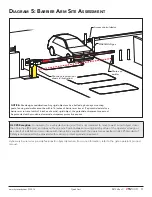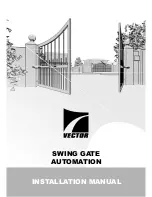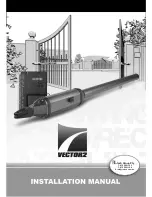
Important Safety Information
WARNING
A moving gate or barrier arm, bollard, or wedge can cause serious injury or death. It is therefore incumbent on the site designer, installer,
and property owner to ensure that these hazards are mitigated and the public is warned of the existence of a potential hazard. Read all the
product safety information prior to installation. Verify the gate operator is installed to comply with all safety standards and local and federal
regulations and is designated for its proper usage class. For more information, refer to your gate operator's product manual.
To reduce the risk of injury or death:
1. READ AND FOLLOW ALL INSTRUCTIONS. Read the gate operator’s product manual and review all the product labels and literature prior to
installing, operating, or maintaining the automatic gate operator.
2. Never let children operate or play with gate controls. Keep all remote controls, especially radio transmitters, away from children. Do not allow
children to play on or around the gate or gate operators.
3. Always keep people and objects away from the gate. NO ONE SHOULD CROSS THE PATH OF THE MOVING GATE. Start the gate operator
only when a gate’s travel path is clear.
4. Test the gate operator monthly. The gate MUST reverse on contact with a rigid object or stop when an object activates the non-contact
sensors. After adjusting the force or the limit of travel, retest the gate operator. Perform routine tests of the entrapment protection sensors,
such as photo eyes and edge sensors. Failure to adjust and retest the gate operator properly can increase the risk of injury or death.
5. Use the emergency release only when the gate is not moving.
6.
+%%0'!4%302/0%2,9-!).4!).%$2EADTHEPRODUCTMANUALS(AVEAQUALIÚEDSERVICEPERSONMAKEREPAIRSTOGATEHARDWAREANDREPLACE
batteries in accessory or entrapment protection sensory devices on a regular basis.
7. The automated gate entry is for vehicle use only. Pedestrians must use a separate entrance. Make sure a separate walk-through entrance is
nearby. Make certain a clear pedestrian path is designated and signs direct pedestrians to the walk-through gate.
8. Install the supplied WARNING signs on the inside and outside of the gate or barrier gate/operator so they are clearly visible from both the
secure and public sides. Installing the signs is a requirement for UL 325 compliance.
9.
5SEMONITOREDSENSORSFORPROTECTIONAGAINSTENTRAPMENTASSPECIÚEDINTHECURRENT5,3TANDARDFOR3AFETY3EE'ENERAL%NTRAPMENT
0ROTECTION0ROVISIONSPER5,4ABLEONPAGE
NOTICE:
Extensive safety information exists in the gate operator product manuals. Be aware and read all safety information, labels and
signage that is shipped with your gate operator to ensure quality site design, proper set up for functional gate operation and pedestrian safety.
This document is a supplement, and as such, focuses on the differences in monitoring external entrapment protection sensors and the
application of external sensors. Be sure to read all the information provided with your product manuals.
S
AFETY
I
NFORMATION
S
PECIFIC
TO
M
ONITORED
E
NTRAPMENT
The following is found in HySecurity
Programming and Operations Manuals,
but re-iterated here. Before installing the
gate operator:
Mount access control devices beyond reach of the gate. The control devices that operate the gate must:
•
Be located in a clear line of sight to the gate. Locate controls (Open, Close, Stop/Reset) where a user will have a clear view of the gate.
NOTE:
An exception for Emergency Access Control devices exists. An EAC device accessible by authorized
PERSONNELONLY EGÞREPOLICE%-3MAYBEPLACEDATANYLOCATIONWITHINTHELINEOFSIGHT
•
Be mounted beyond 6 feet (183 cm) of the gate to prevent users from touching or accessing the gate while operating the controls. People
attempting to access the controls by reaching through or around the gate can be seriously injured or killed by the moving gate.
•
Connect radio and other remote access (non-resetting controls) to the RADIO OPTIONS terminal.
Install an automatic operator only on gates that comply with ASTM F2200 Gate and Fence Standards and the usage class of the gate. Screen or
enclose openings in the gate per UL 325 Standards for Safety which include:
•
All horizontal slide gates must guard or screen openings from the gate’s base support to a minimum height of 6 feet (183 cm) above the
ground. This must prevent a sphere of 2¼-inches (57 mm) in diameter from passing through an opening in the gate or the adjacent fence that
is covered in the gate’s open position.
•
All exposed pinch points are eliminated or guarded.
•
Physical stops must exist in the gate construction to prevent over-travel in both directions and, for slide gates, guide posts must be installed
to prevent the gate from falling in the event of a roller failure. Guarding must be supplied for exposed rollers.
•
External entrapment protection sensors must be used wherever the risk of entrapment exists. Refer to page 5.
SAVE THESE INSTRUCTIONS
2
D0726 Rev. C
UL 325 - 2016 HySecurity Monitored Sensors
©
2016 www.hysecurity.com
Summary of Contents for UL 325-2016
Page 33: ...Page intentionally left blank...
Page 34: ...Page intentionally left blank...



































